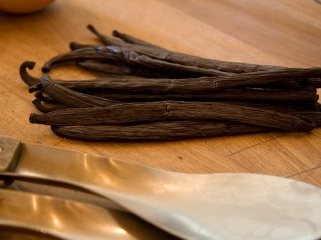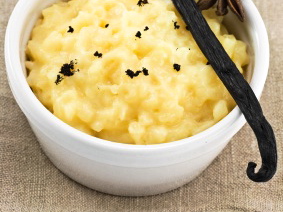
feature-image, l
(article, Nancy Rommelmann)
[%pageBreakSettings nobreak=true] When my father remarried, his new wife — perhaps in a bid to preemptively avoid the wicked-stepmother role — gave me a bottle each of her two favorite perfumes. The first was Joy, by Jean Patou, at the time said to be the most expensive fragrance in the world. It was heady and luminous and dense with rose, and came in a flacon so exquisite I erected a little shrine for it in my teenage bedroom. [[block(sidebar). h1.Featured recipe]] The second was a bottle of McCormick’s vanilla extract, which retailed for about $2.49. This bottled essence, she told me, had been a standby of hers since she was a girl, a North Carolina peanut farmer’s daughter for whom the idea of real perfume was “as far away as the moon.” This was more than 20 years ago, and while I still love (and still have) the Joy, I would sooner give it up than the cheap vanilla extract, which I suppose I could live without but choose not to. Not that I haven’t dallied (as did, ahem, my former stepmother) with other types of vanilla; I have, and here's a list of what I've learned about them. [[list(culinate8). #(n1). [%image feature-image float='clear right' width=400 credit="Photo: iStockphoto/Millobixo" caption="Vanilla beans should be dark and supple, not pale and dry."] Vanilla beans. Beautiful, aren’t they? So sexy, so pliant, and so full of promise, these cured orchid fruits come to us all the way from Madagascar and Indonesia, China and Tonga. Who can resist? You can, when what you’re considering buying looks like a hard little twig. Search out instead smooth, flexible pods plump with speck-like seeds. While vanilla pods will vary by country of origin (Bourbon beans from Madagascar are long and slender, with oily skins and a strong vanilla aroma; Mexican beans are more redolent of wood and spice; Tahitian pods are shorter and fatter, with a fruitier smell), they are best used in custards and ice creams, recipes where the pod (which is more flavorful than the seeds) can be infused into the liquid. Use care, however, not to add vanilla – beans, seeds, or extracts – to hot liquids, as heat will stamp out vanilla’s flavor and aroma. #(n2). Mexican vanilla extract. The birthplace of Vanilla planifolia, the orchid that produces vanilla pods, Mexico is currently responsible for only about 3 percent of the world’s annual output. What happened? The orchid turned out to grow fairly well in Indonesia and Africa, among other climates, including (though not in commercial quantities) south Florida. That Americans still think of our vanilla as coming from Mexico — and occasionally it does, with a flavor that ranges from mild and sweet to woody and spicy — may be due, in part, to our encounters with a panoply of vanilla products when we cross the border. (Note: See below for the sorts of vanilla you don’t want to pick up on your next trip through Tijuana.) #(n3). Madagascar vanilla. Madagascar is the planet's leading producer of vanilla (about 6,200 tons a year, or 70 percent of global consumption). The island's vanilla, widely considered the world's finest, is called Bourbon vanilla after the former Ile de Bourbon (now La Réunion) located in the Indian Ocean east of Madagascar. It's velvety and mouth-filling and mellow enough to be used as an everyday vanilla. #(n4). Vanilla paste. Pure vanilla extract with the seeds mixed in, vanilla paste seems more urbane than extract, while not as much work as beans. It suggests both the baker’s acumen and insouciance, a way of saying, "Look! I give you the real thing, but with no effort!" Nielsen Massey, which makes an excellent paste, sums it up when they say their product "adds a gourmet appearance to any recipe." #(n5). Supermarket vanilla extract. In other words, the McCormick’s most of us grew up with, also available as store brands. It’s the taste I most often want in cookies, pound cakes, brownies, anything I dose with vanilla: neutral and sweet, with a high-alcohol vanilla hit. Those two-ounce bottles of extract at $6.99 add up, however, especially if you, like me, tend to double the vanilla in any recipe you use. For a great alternative, try Costco's house brand, Kirkland, which, when I last checked, cost a mere $7.99 for 16 ounces of Madagascar Bourbon vanilla. #(n6). [%image promo-image float='clear right' width=300 credit="Photo: iStockphoto/maceofoto" caption="Rice pudding with a scattering of seeds scraped from a vanilla bean."] Homemade vanilla extract. It's simple: Slit four to six plump vanilla pods lengthwise, plunge them into a fifth of flavorless vodka (for a clear vanilla taste) or bourbon (for a more caramel/smoke flavor), then put the bottle in a cool dark place and allow to steep for about six weeks. Siphon off the extract, or use it as needed. Depending on the condition of your beans, you may be able to pour on more alcohol and re-steep. Alternately, you can plunge the semi-spent, patted-dry pods in sugar, for vanilla sugar. You can of course make the latter with fresh vanilla beans, though personally I don’t find enough uses for vanilla sugar to merit such a sacrifice. #(n7). Vanillin. A synthetic vanilla made from wood pulp and to be used under no circumstances. This is not snobbery; while I can think of good uses for margarine (oatmeal cookies), yellow cake mix (Dump Cake, to be addressed in a future column, no doubt), and marshmallow fluff (Fluffernutter, duh), I can think of nothing that will not taste worse for the use of vanillin, with its flat, chemical flavor and a smell somewhere between alcohol and mosquito spray. And really, why encourage its use, when an estimated 95 percent of “vanilla” products — including imitation vanilla extract — already contain vanillin. #(n8). Other vanillas to avoid include the cheap, tar-smelling vanilla sometimes sold in Mexican tourist towns; a quart can sell for as little as $5. This is almost surely not made from vanilla beans but from tonka beans (or some combination thereof); tonka beans contain coumarin, a moderately toxic compound used medically as a blood thinner but banned as a food additive. Another Mexican oddity is something called "natural vanilla concentrate," which has all the potency of weak cream soda. Finally, there's Trader Joe's Cookie Vanilla and Pure Bourbon Vanilla Extract. Don't get me wrong; I love Trader Joe, I love almost everything he makes, and damn if I don’t walk in needing two things and walk out pushing a cart the size of a pony. But with the exception of his excellent vanilla paste (whose ingredients are, by the way, identical to Nielsen Massey’s), his vanillas are a bust; the Cookie Vanilla is gluey and candy-corn sweet, while the Pure Bourbon Vanilla Extract is both bitter and weak. Save your pennies for something better. ]] p(bio). Nancy Rommelmann lives in Portland, Oregon. Her writing appears in the LA Weekly, the Los Angeles Times, Portland Monthly, and Bon Appétit, among other publications.

feature-image, l

promo-image, l

reference-image, l